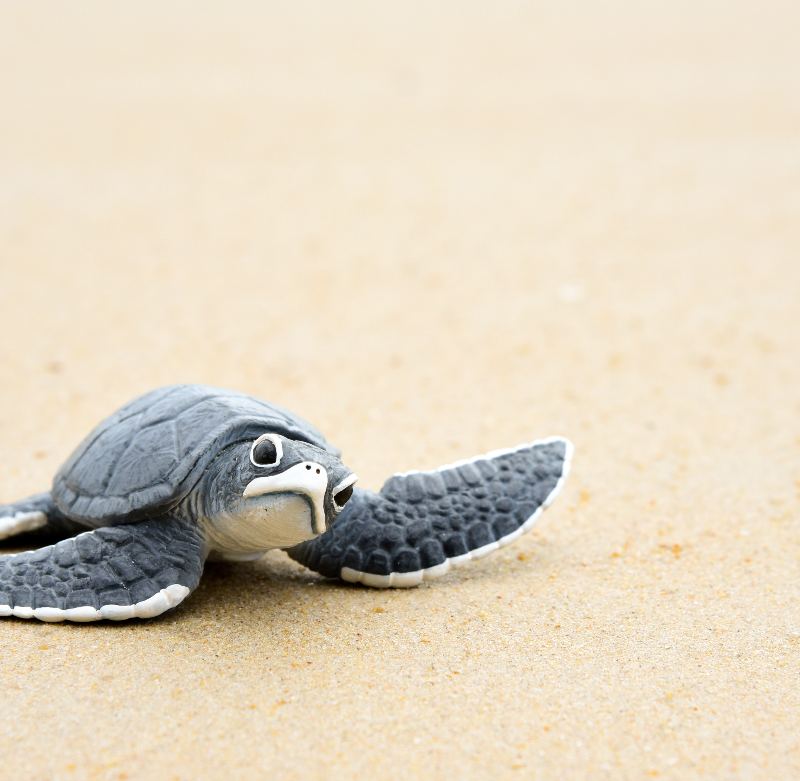
Along the Gulf Coast of the United States, an incredible event occurs between the months of June and November. A sound reminiscent of steady rainfall emanates from the sand. Soon after, some 45 to 75 days after being deposited in deep holes by their mothers, hundreds of tiny sea turtles emerge, their newborn eyes straining to find their destination, the sea.
Videos by TravelAwaits
The hatching of newborn sea turtles is a miraculous sight to behold. The journey is perilous: The tiny youngsters face overwhelming odds just to make it to the ocean, and then they face dangers that lurk out in the open water. Their odds of survival are enhanced by the watchful eye of volunteers who monitor the nests and do all they can to protect them. But the volunteers can only do so much, and it is up to beachgoers to ensure that the turtles have a fighting chance of survival.

Sea Turtles In America
In the U.S., sea turtles nest on the beaches of Hawaii, Puerto Rico, the Virgin Islands, the southeast Atlantic coast, and the Gulf of Mexico, with over 90 percent of nests being found in Florida.
Six species lay their eggs on U.S. beaches, the smallest being the Kemp’s ridley, olive ridley, and hawksbill, all of which weigh around 100 pounds. The green and loggerhead turtles weigh about 300 pounds, with the loggerhead being the most abundant of the nesting turtles in the States. The leatherback turtle can weigh up to 2,000 pounds. All six species are on the endangered species list.

The Nesting Process
Nesting season runs from around March through October, with the eggs hatching 45 to 75 days later, mainly between June and November. Under the cloak of darkness, the mother sea turtle returns to the same location each year, making her way up onto the beach, where she digs an 18-to-24-inch-deep hole with her powerful flippers. She then lays anywhere from 30 to 200 ping-pong-ball-size eggs.
The nest is not a safe haven for the eggs. Land-based wildlife like foxes, raccoons, and crabs can dig up the nest and eat the eggs.
When they are ready, the babies begin to crack out of their shells. As the shells break, the sand begins to collapse, making a sound like a rain shower. It could take up to seven days for the last hatchling to appear.
The trip to the ocean is a perilous one, and the hatchlings are not out of the woods. A variety of birds and land-based predators wait in the wings to catch them. Once at sea, the hatchlings float freely in the open ocean or on sargassum mats for up to two years before they begin swimming about in the ocean currents. They are easy pickings for groupers, snappers, and sharks until they are big enough not to be eaten.
As dangerous as nature is for young sea turtles, humans can be just as threatening to turtles of all sizes. Inquisitive humans poke, prod, and dig up nests, often breaking the eggs, and fishermen catch the turtles in their nets.

7 Ways You Can Give Baby Sea Turtles A Fighting Chance
As I mentioned earlier, beachgoers play an important role in helping sea turtles survive. Here are seven ways that you can do your part to help save sea turtles when you are visiting your favorite beach for a little fun in the sun.
1. Turn Off The Lights
All turtles except the Kemp’s ridley lay their eggs at night. Mother sea turtles are guided in part to their nesting area by the light of the moon. Artificial light — like that from a flashlight or from a beach-facing hotel room, beach house, or condominium — can disorient them and cause the turtles to travel higher up onto the shoreline. There have been incidents where streetlights have done the same, and turtles have tried to lay their eggs near highways or in the ocean.
Babies can also become disoriented by artificial light as they try to make their way to the ocean at night.
Leaving the lights on in your beach-facing property or using a flashlight while on the beach is not a good proposition. If you are spending a few days at a beachfront property, check with the owner or manager about their light policies during nesting season.
2. Pick Up Trash — Even If It’s Someone Else’s
We have seen too many summers where turtles have been tangled up in discarded fishing lines or have gotten their heads or flippers trapped in the plastic rings that hold beverage cans together.
When at the beach, pack a plastic bag and clean up the trash, even if it’s not yours. And if you do pick up any of those plastic beverage rings, before putting them into your trash bag or sending them off to recycling, cut the rings so that there are no complete circles that could ensnare a turtle (or any other animal, for that matter).
3. Leave The Sand The Way You Found It
Kids and grown-ups alike love to dig deep holes in the sand and build giant sandcastles. But sandcastles are obstructions for turtles, who might not be able to get around them. Female turtles may be forced to lay their eggs too close to the waterline, where they cannot hatch. Hatchlings facing one of these daunting structures may also become disoriented and head in the wrong direction.
Deep holes are death traps for turtles. They can easily fall in, and unless they are rescued by passersby, they will die.
It’s important to fill in the holes and level the sandcastles you’ve made before leaving the beach for the day.
4. Don’t Leave Beach Gear Out Overnight
If you are spending a fun-filled vacation on the beach, you probably have accommodations right on the shoreline. It’s easy to get into vacation mode, hauling your gear — your beach chairs, umbrellas, and coolers — out for a day of summertime fun and then leaving it on the beach overnight so that you can start over in the morning. That’s convenient for you, but hazardous for turtles.
You would be surprised just how determined a female turtle can be when it comes to building her nest. Photos from the U.S. Fish and Wildlife Service a few years ago showed a huge sea turtle barging her way through beach umbrellas and chairs. Some never make it back to the ocean, since they get tangled in the gear.
Please take the time to bring your gear in at night.
5. Leave Sea Turtle Tracks Undisturbed
You will know turtle tracks when you see them. The large flippers of a sea turtle make incredible tracks that lead directly to where they lay their eggs. This is how volunteers know where a nest is located, and they can mark the area and install protective devices to keep predators out.
6. Never Disturb A Nest
It should go without saying, but never disturb a nest. First of all, it is a federal crime. If you see tracks leading up away from the waterline and volunteers have not yet marked the nest, notify the U.S. Fish and Wildlife Service immediately.
7. Volunteer
Besides everything I have listed above, one of the best things you can do to help sea turtles is to volunteer to protect and monitor these incredible creatures.
Volunteers patrol beaches, looking for nests. They mark the ones they find with signs and fencing to keep people away. Once a perimeter has been established, they dig up the nest, count the eggs, record the exact position and direction they were found in, and then carefully put the eggs back exactly how they found them. In many cases, they install special metal grates to keep predators out.
After 45 days, they begin monitoring the nest for signs of life, and when they hear the sound of cascading sand, they notify other volunteers, who gather around to make a path to the water that helps lead the newborns to their new home.
It is an amazing sight and a grand payoff for all of the hard work. Each city and state has its own volunteer group that assists U.S. Fish and Wildlife rangers during nesting season. The best way to find out where you can volunteer is by visiting the U.S. Fish and Wildlife Service’s volunteer website.
